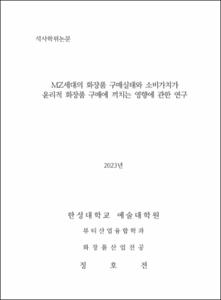MZ세대의 화장품 구매실태와 소비가치가 윤리적 화장품 구매에 끼치는 영향에 관한 연구
= A study of the Effects of MZ Generation's Cosmetics Purchasing Status and Consumption Value on Ethical Cosmetics Purchase
- Files in This Item:
-
-
Download
 200000654424.pdf
기타 데이터 / 920.89 kB / Adobe PDF
200000654424.pdf
기타 데이터 / 920.89 kB / Adobe PDF
-
Items in Repository are protected by copyright, with all rights reserved, unless otherwise indicated.